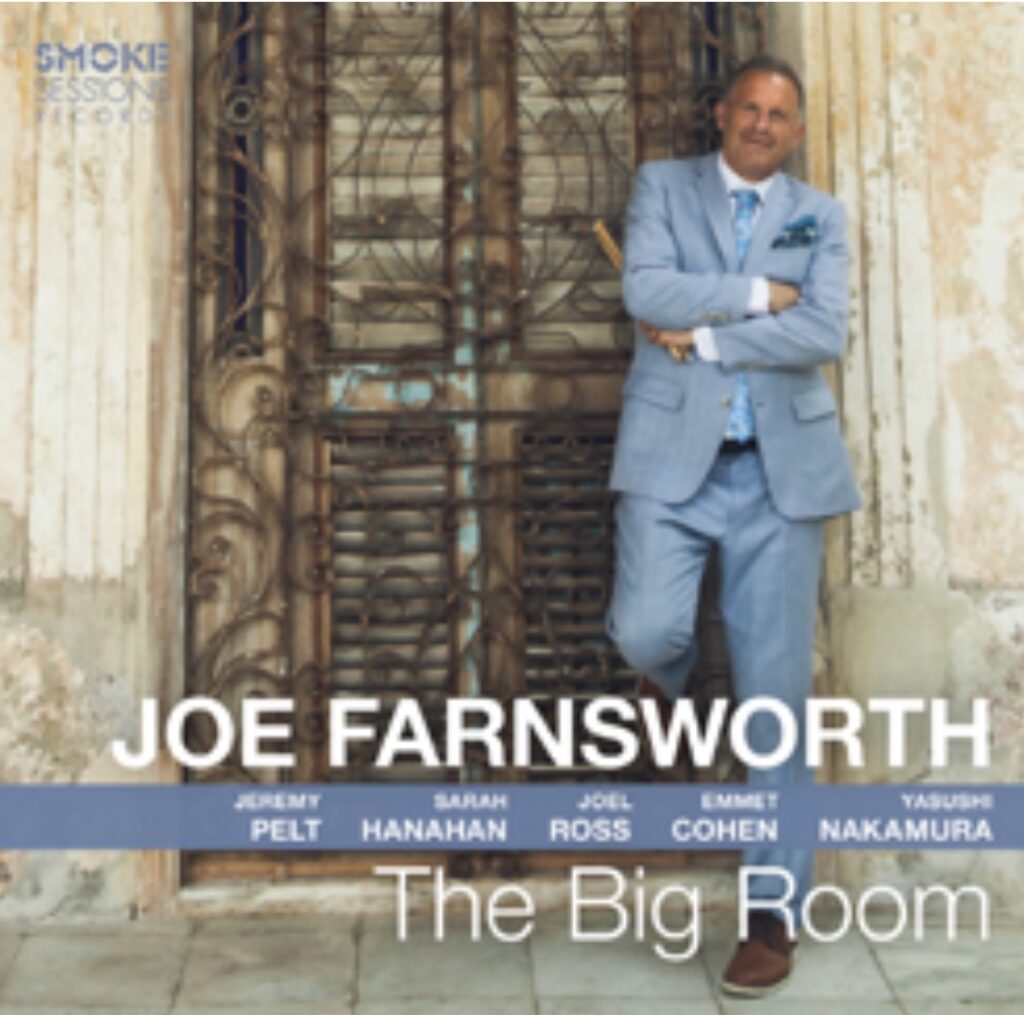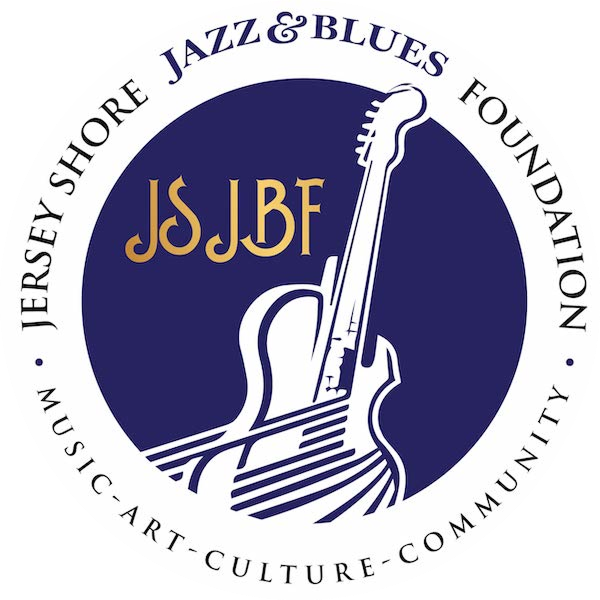Joe Farnsworth’s ‘Big Room’
Drummer’s New Album, Set for July Release, Honors the Legends He Grew Up With
“It’s Got That Vibe, That Swing, That Soul. It Was My Way of Saying Thank You to the Ones Who Built This Music …”
By Jay Sweet
Originally published in Jersey Jazz Magazine. Published in New Jersey Jazz Society (July/August 2025, Volume 53, Issue 07)
Joe Farnsworth has been one of jazz’s most impressive, hardest swinging, and most sought-after drummers of the past few decades. Growing up in South Hadley, MA, Farnsworth came from a musical family and studied with greats such as Alan Dawson and Art Taylor early on, while also attending William Paterson University. His skills and incredible adaptability led him to play and record with so many greats, such as pianist Harold Mabern, saxophonists Benny Golson and Pharoah Sanders, and vocalists Jon Hendricks and Annie Ross, to name a few.
In addition to enhancing every group he plays with, Farnsworth has recorded several albums as a leader. His new album, The Big Room, is set for release on July 25 on Smoke Session Records and features an all-star band: trumpeter Jeremy Pelt, alto saxophonist Sarah Hanahan, vibraphonist Joel Ross, pianist Emmet Cohen, and bassist Yasushi Nakamura.

“The ‘big room’,” he explained, “is something I remember hearing Max Roach and Jackie McLean talk about. I think maybe they picked it up from Charlie Parker. It’s like this next dimension you enter when you’re playing, this space where there’s nothing there at first, but you can arrange everything however you want. You furnish it your way. It’s freedom. Pure freedom. You’re not thinking, you’re not strategizing—you’re just being. It’s like a fourth dimension.
“Very few people get there,” he continued. “Coltrane did. Bird did. Max talked about doing it with Bird. I remember asking Billy Higgins once how he played the way he did, how he smiled so much while playing. And he said something like, ‘I’m just grateful I get to live and play free, just be myself.’ I didn’t understand it then, but the older I got, the more I felt it.
“I spent so many years trying to sound like Max Roach or trying to fit in—playing with guys like Cedar Walton or following up Billy Higgins. I tried to play a perfect Max Roach solo for 40 years—and I never did. Not once. And when you’re chasing someone else’s perfection, it’s hard to be free. That’s what the ‘big room’ is about: reaching that place where you’re musically, mentally, emotionally, and spiritually free, to say what you mean and mean what you say honestly.”
He recalled playing with Ron Carter one time for “four nights, eight sets. We were so excited. Every tune, he just played quarter notes. Pounding them into us. And it was beautiful. But on the last song, he suddenly played this triplet—hit this note that stopped everything. It was so bad, in the best way. And he just looked at us as if to say, ‘Welcome to the big room.’
“Man, that moment stuck with me. It was as if he had opened the door, let us peek in, and then closed it because we were finally ready. I used to see Jackie McLean with Cedar Walton and Billy Higgins. They’d be playing ‘Lover’or ‘rhythm changes’, and the energy between them, especially the rhythmic thing Billy and Jackie had, was so intense.” (“Rhythm changes” is the name given to a popular 32-bar jazz chord progression based on George Gershwin’s “I Got Rhythm”. It’s a familiar arrangement used in jazz improvisation and is the basis for many jazz standards).
To get to the “big room,” Farnsworth chose a special group of musicians, each with a unique sound and concept, and each representing a different background and age demographic. Was he was able to get “the big room” on this recording?
“I was trying to. The first person, of course, was my friend Sarah Hanahan, from Marlborough, Massachusetts. We’ve been playing together since the pandemic started. We’ve traveled a lot and grown together musically. And, honestly, just before Covid hit, I lost three of my biggest mentors—people I based my whole musical life around: Harold Mabern, Pharoah Sanders, and McCoy Tyner. When they passed and the world shut down, everything had to be reassessed. Everything. (Sarah Hanahan was a Jersey Jazz Rising Star in the September/October 2020 issue. Her Blue Engine album, Among Giants, was named one of Down-Beat’s 12 Best Albums of 2024).
“During that time, I saw Emmet Cohen doing all these livestreams and getting like 10 million views. I thought, “Let’s join in on the fun!” So we did one—and got about 10 people watching. The following week, 15. I joked, ‘At this rate, in 50 years we’ll catch up to Emmet.’ But we kept going.
“And then, one week, this young woman showed up holding an alto saxophone. The way she held it—it was like she was sparring, hitting the speed bag. It had that kind of energy. And then she sat in and played, and it was incredible. Playing with her gave me that same feeling I had when I played with Pharoah.. She became the focal point of the record. Then I just needed to surround her with people I love being around.
“Emmet Cohen is a fantastic pianist. I call him a modern-day Benny Golson. He brings this majestic energy to everything he does—musically, personally, spiritually. Yasushi Nakamura on bass is a young legend to me. His sound is royalty. His bass lines feel like Tommy Flanagan meets Billy Strayhorn meets Oscar Pettiford. You can go anywhere with him. I also brought in Joel Ross, whom I’d seen online but hadn’t played with before. He was everything I hoped for and more. And then, of course, Jeremy Pelt—a real pro’s pro. Having him there just gave me confidence. It’s like going into a game seven , Celtics vs. Sixers, and you’ve got Bill Russell anchoring the team, you just feel good. That’s what Jeremy brought. So yeah, I really do feel like we got to the Big Room.”
Farnsworth took a unique approach with the album, relying on each member to offer a tune to showcase, not only their musicality as players, but also as composers. “The great thing about this record,” he said, is it’s a record. We made it like a vinyl. That’s what we grew up on, vinyl. It told a story. You had 18 minutes on Side A, then you’d flip it over to Side B. There was a beginning, a middle, and an end. And it all worked together; it flowed. So that’s how we approached this one. For example, I knew if Sarah was going to offer a tune like ‘Continuence’, I wouldn’t follow that up with something random. It had to go somewhere new. That’s where Joel Ross came in with ‘What Am I Waiting For’. His sound took us to a different space we hadn’t explored before. He brought a spiritual dimension that expanded everything.
“Then there was Jeremy Pelt. Every time I put on a record, I always go looking for the blues. I want to hear how people play the blues. That’s how you really know what a band is about. So I asked Jeremy to write me a blues for this album, and that’s the role he played with ‘All Said and Done.’ Emmet Cohen wrote this tune ‘You Already Know’ that we’ve been playing live, and I just love it. It’s freewheeling. I didn’t have to overthink. I could just let go and play with energy and joy. And then there’s ‘Primetime’, a tune I wrote. That one’s an homage to Harold Mabern, Jackie McLean, Billy Higgins, Curtis Fuller—all the Blue Note cats I love. It’s got that vibe, that swing, that soul. It was my way of saying thank you to the ones who built this music, who showed us the way. That’s how the album came together. Each piece served a purpose, contributing to a cohesive narrative arc from start to finish. We weren’t just laying down tracks. We were telling a story.
“We recorded the album at Smoke, which was special. What made it extra cool is that we weren’t in some isolated studio booth. We were upon the actual stage, just like we were playing a gig—only without an audience. That made all the difference. The sound, the feel; it had the energy of a live set. We knocked it out in about four hours. From September 3-7 at Smoke, the whole band from the album will be back together, and we’ll bring this music to life, on the same stage where we recorded it.”
